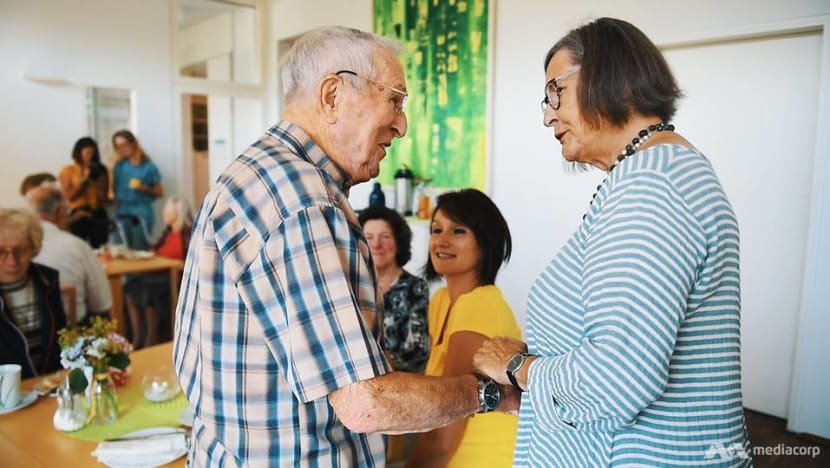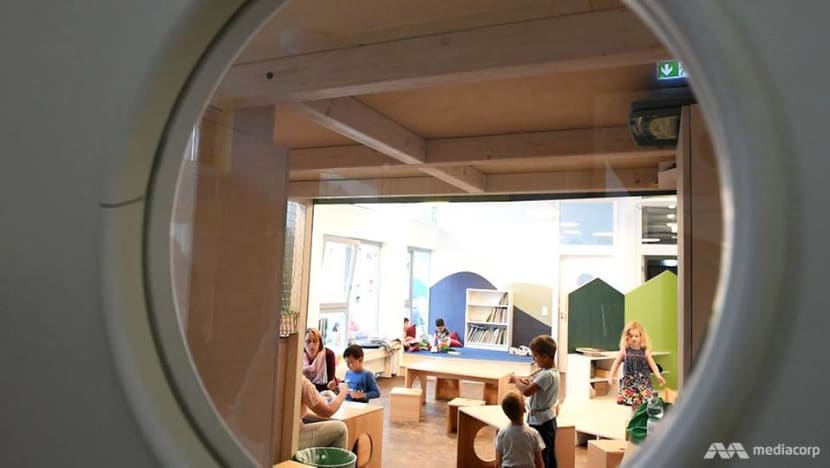'It's like I’m part of life again’: The magic when seniors and kids do daycare together
As Singapore starts to co-locate care centres for the elderly and children, CNA Insider visits a groundbreaking project in Germany that has gone even further - and made the old feel young and purposeful again.

Siglinde Marckart, 80, teaches a game to her little friends at daycare - and CNA Insider's Goh Chiew Tong (middle) gets to see just how this pilot project is making the old feel young and useful again.
SALZGITTER, Germany: On little Mia’s last day at her care centre, her playmates gathered around singing farewell songs, as she handed out bags of sweets. One by one, they hugged her. “Come here you little pumpkin,” said one with a toothless grin. “You’re a cutie, we’re going to miss you,” said another.
What’s unusual about this scene is that Mia’s best friends aren’t all toddlers like her – they include white-haired old grannies and filmy-eyed granddads.
At this care facility, there is little that separates the generations, despite the decades between them.

During play sessions together, the seniors seem to shed their years as they watch the young ones run around. Kiddy giggles fill the room during games and storytelling sessions led by the old folks.
Folks like Siglinde Marckart, 80, who lives alone and grieves the recent loss of her brother. But you wouldn’t think it from her warm smile and laughter, as she teaches a group of squealing children a game of hand-tag that she learnt from her own mother.
“I feel younger, my head is clearer. It’s like I’m part of life again,” said Mrs Marckart, who has early-stage dementia.
It may not seem like it, but a small revolution is taking place here on the second floor of the Mutterzentrum or Mother Centre, a multigenerational facility in Salzgitter city.
It’s an experiment that, if 74-year-old co-founder Hildegard Schooss has her way, could lead a sea-change in how daycare of the elderly and the young is modelled across an ageing Germany – and show the way for Singapore and the rest of the world, as well.

HEALING THE GENERATION GAP
It would not be the first time that this light-filled, airy building in the small district of Salzgitter-bad – population 20,000, about the same as that of Kovan or Tanglin in Singapore – has been the epicentre of nation-wide change.
In the mid-2000s, the centre came to national attention for its then-groundbreaking concept of serving as a “public living room” where mothers, children and the elderly could drop in to socialise over a café meal, volunteer their help to each together, and get professional day care services all in one place.
This inspired Family Minister Ursula von der Leyen to launch some 500 multigenerational centres across the country, supported with federal funding, in answer to Germany’s ageing population crisis.

But for all its success, this model wasn’t enough for Mrs Schooss.
Since 1990, her centre had been running separate structured daycare for children and seniors, albeit under one roof. At the start of 2018, she wanted to see if there was a way to merge them, so the two groups would have more than just ad hoc interactions.
“Whenever I observed our staff with the children or the elderly, I noticed that many things could be done together,” she said. The more she thought about it, the more “unnatural” it seemed to keep the two age groups apart.

In Salzgitter-bad – where nearly one in four persons is over the age of 65 – many seniors live alone. And children who mostly grow up in nuclear households rarely get to interact with old folks.
“Society is suffering from a gap between the generations,” said Mrs Schooss. “And it is depending on reconnecting generations in order to get well again.”
A similar predicament is faced in Singapore, where 1 in 4 persons is expected to be 65 or older by 2030, and experts have warned of an epidemic of elderly loneliness.
Already, the concept of care facilities that bridge young and old is taking nascent shape: In 2017, the Government announced plans to co-locate eldercare and childcare facilities in 10 new housing developments.
READ: Kampung Admiralty welcomes its first batch of residents
But, the example of Salzgitter’s multigenerational centre – and in particular, Mrs Schooss’ latest joint-care concept – show just what tremendous potential could be mined from such projects here.
They could have a significant impact not only on the well-being of seniors, but also on children’s development and intergenerational bonds – and, in the long run, even provide sustainable answers to the shortage of care manpower as family sizes shrink.

EACH OTHER’S SURROGATE FAMILY
But when Mrs Schooss first raised the idea of combining daycare services for children and the elderly, her staff were skeptical.
"They said it was not possible - ‘our old people wouldn’t want this’ or ‘the children are not allowed to do this’. And that made me furious,” said Mrs Schooss.
Staff wouldn’t let the children spend time alone with the seniors because by law, children in a daycare center are not allowed to be left unsupervised without a qualified caretaker. “It’s unbelievable the number of safety regulations.”
Then, there were some parents who did not like the idea of “having old people touch their children”. Even the seniors themselves said the kids were “too naughty” and “too loud”.
But over time, these complaints dwindled.

Both the seniors and the children still have their separate programmes: Physical and memory training for the seniors, and the usual kindergarten curriculum for the children.
But the rest of the day’s schedule is filled with as many combined activities as possible.
Take the music and dance sessions. The children prance around the room while the seniors, infected by their energy, join in. Even limited as they might be to slow bobbing movements, this serves as physical therapy.
Seniors get triggered by the children. We notice that they smile a lot more when the children are around.
"They want that contact,” said Laura Kutschert, 27, one of the programme’s researchers.

As for the youngsters, said Mrs Schooss, “they have enormous respect for the seniors. Many of them don’t have grandparents… and with their parents’ working hours, they barely even have time with their own family.”
In short, the old folks and the children become a kind of surrogate family to each other.
“We are trying to reinvent here what was totally normal decades ago,” said staff member Nicole Hummers. “Where three or four generations lived together under one roof, where grandma plays with her great-grandchild.”

FEELS LIKE HOME
Unlike the clinical feel of a typical care center, the house – which opens five days a week, from 7am to 7pm – is cosily furnished with many breakout areas reminiscent of an Ikea showroom.
Natural light floods the hallways, and the smell of cookies and cakes from the kitchen lingers.

The phrase they like to use to describe this pilot programme is “kindred by choice”. And its “family” of clients currently comprises 25 children and 16 seniors.
Supporting them are 16 centre staff, researchers and volunteers, who include kindergarten teachers and caregivers. Responsible also for cooking and cleaning, the team runs the place like a household and are called “mothers”.
It’s part of the daily routine for the seniors and children to help the “mothers” prepare lunch. Each senior is paired up with a child to perform simple tasks like peeling and chopping, and helping to set the tables.

During meals, the old folks fuss over the children, often helping to cut their food into smaller pieces, or teaching them to use their fork and knife the right way.
“You can see that they really care about the children,” said volunteer Ursula Scholz. “It’s like they have found a new lease of life. You can’t get this in a regular nursing home.”

Then there is the boy who always hangs around the elderly folks because he doesn’t fit in easily with the other children.
“He needs a special atmosphere, and he gets the warmth he needs from the elderly people more than from the other kids,” said Mrs Schooss.
The services are accessible to most, as kindergarten fees are subsidised while the seniors can tap their state-mandated Long Term Care Insurance to help pay for the daycare fees – it costs them between 40 and 70 euros a day, depending on their assessed level of care in their insurance plan. The project is also financially supported by the state of Lower Saxony and a foundation.

STUDYING THE OUTCOMES
While such achievements and benefits may seem anecdotal for now, the centre has hired a team of researchers to study the outcomes of the pilot programme over time.
“Our main aim is to study how seniors and kids are can be taken care of together – does it work and if so, how?” said Ms Kutschert.
For instance, research out there has shown that an active mind keeps certain age-related diseases and symptoms like dementia at bay.

“A lot of doctors have referred their patients with dementia to us. And we have noticed that those patients who use our services are benefiting from it,” said Mrs Schooss.
Mrs Marckart, for one, was greatly affected when her brother died. She had moved to Salzgitter only two years ago and had no other family around her.
“When I am home alone, all I think about is the past and I get sad. Here (at the centre), I can switch off and look forward to something,” she said, noting that her thoughts felt clearer and more alive.

The study will take three years to complete, and with the research findings, the centre plans to come up with a proper curriculum and method of training staff to care for both children and the elderly. Currently, there are no professional courses on intergenerational care.
In Germany as in elsewhere like Singapore, where professional care services face a shortage of manpower, it could be an advantage to have staff who can look after both young and old at joint-care centres.
SPARKING A MOVEMENT
For Mrs Schooss, pulling off that paradigm shift in thinking about care would be another milestone on a long road.
It all started when she moved to Salzgitter with her three children in the 1980s because of her husband’s job. “I felt completely alone. I had to do something or I would get sick,” she said.
So she rented a small shop and started baking cakes. Anyone who came through the door was offered a slice and a cup of coffee. “I wanted a place like my parents’ home where the doors are always open and there’s someone I can talk to.”
Soon, it became a support group for mothers and kids in the neighbourhood and they called themselves the “mother center”.

But then, to Mrs Schooss’ surprise, seniors started showing up too – some to ask for help with chores, others for the company.
Quite organically, the different generations bonded over gardening, sewing and meals. The centre began offering daycare services by trained caregivers, and was reconceptualised as a multigenerational house.
In the mid-2000s, Germany’s changing demographics put worries about an ageing population in the national policy spotlight. And the Salzgitter centre caught the eye of Family Minister von der Leyen.
The result was the Mehrgenerationenhaus programme, a roll-out of hundreds of meeting places across the country where the young and old could volunteer their services to each other: Seniors offering to mind children or read to them, youths helping to do grocery shopping for the elderly or teach them computer skills.
WATCH: The magic of interaction between young and old (10:07)
Dr Eckart von Hirschhausen, an author and patron of a multigeneration house in Berlin’s Zehlendorf district, described them as “the model for the future: learning from one another, feeling needed, sharing joy”.
‘MY GRANDPA DIETER’
At the heart of every multigenerational house is supposed to be the food – the drawing point that helps bring many of the 600 ad hoc visitors in to the Salzgitter centre each day. Serving affordable fare from lasagna to cheesecakes, and with a barista, its cafeteria encourages people who range from seniors to refugee mothers to linger, mix and chat.
The two-storey, 2,500 sqm facility also offers a daycare room for mums who want to drop off their kids for a few hours; a games room hangout for teenagers; an outdoor kids’ playground; a laundromat; and seating spaces for seniors.
And it doesn’t take a structured programme like the pilot joint-care project to spark friendships across the generations here.
Mr Dieter Huber, 72,a volunteer at the centre for 14 years, is known – especially by staff member Ms Hummers’ four children – as the doting “Grandpa Dieter”.

When mum says no to ice cream, he sneaks one under the table. And sometimes he offers to take the kids out at the weekends so Ms Hummers, a single mum, has time for herself. “It’s difficult for her. Her day is full of the kids’ appointments to dentists, doctors, all these obligations,” said Mr Huber.
“Dieter has become like family to us,” said Mrs Hummers’ second child Michelle, 17. “Our grandparents live in Cologne and we’re not close to them.”
It’s little wonder that the centre has been used as a case study for elder care researchers around the world. Mrs Schooss has been regularly featured on national television and in the international press, and gives talks in countries as far away as South Korea.

“I think we have done good work to spread this concept to the outside world,” said Mrs Schooss.
In Germany, the multigenerational house’s example will be timely since, by 2030, seniors will make up a third of the population – placing more pressure on its already-stressed long term care systems. “There will be a need for more arrangements like this centre, and it will be a step forward for society,” said Mrs Schooss.
Ms Hummers agrees. “My colleagues and I hope that we’ll get to spend our old age in a place like this – it would be beautiful,” she said.
CNA Insider’s trip to Germany, to study its approach to long-term care for the elderly, was supported by the Lien Foundation. Read Part 1, in which we visited the dementia-friendly community of Arnsberg.


















